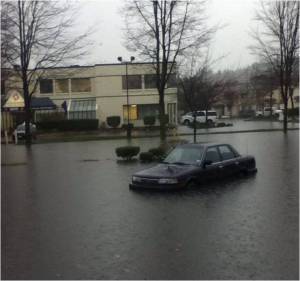23 Feb Start wishing for a late spring and take precautionary measures

Though the calendar says spring is less than a month away (March 20th), New Englanders may start wishing for a late arrival to allow snow and ice to gradually melt. Why? Though the weight of snow and ice already may have caused havoc for some, flooding of basements and out buildings is going to be a rude awakening if it rains. “Am I covered?” you ask.
Over the last month, the evening news throughout New England has featured stories of record snow falls, record low temperatures, un-godly wind chill factors, innumerable car accidents and dozens of serious roof collapses. Unfortunately, the worst may be yet to come in the form of flooding.
Some areas of the region already are showing heavy concentrations of water in the snow pack. When added to rivers and streams that have been frozen over for several months, an early or rain-soaked series of storms could unleash millions of gallons of water into communities downstream or through seldom noticed gullies that run through neighborhoods and business parks. Major rivers could be blocked by ice jams leaving riverfront communities in danger.
Another probability is that melting snow with no place to go may flood basements and low-lying structures. For the cautious, now would be a good time to survey homes and buildings that could be damaged by heavy spring run-offs. Some precautions include getting snow away from building foundations, shoveling run-off paths to channel water away from properties and elevating items stored in basements BEFORE any warm weather event occurs.
The primary reason to take preventive measures now is because most homeowner’s insurance policies do NOT cover flooding when water enters from outside the building even if there is flood insurance for the property. To be classified as a flood, adjacent properties must also flood. To determine if there is coverage, a conversation with your independent insurance agent would be time well spent.
So how about all the other mishaps and damage that have been caused by this winter’s unusual weather and how have insurance policies responded?
Frozen pipes. Lots of claims are coming in for water damage from burst pipes. Most homeowner insurance policies cover pipes that freeze and burst. The obligation of the homeowner is to stop the damage from getting worse as soon as the leak is discovered
- Shut off the water and call a plumber
- Clear floor drains and sump pump pits to get the water out and use a water vacuum, squeegees and towels to remove as much water as possible
- Place box fans or rent industrial blowers to evaporate any lingering water and reduce the possibility of mildew and mold
- Calling a mitigation firm such as ServPro or ServiceMaster to assess the extent to which additional measures should be taken
Another common claim is damage caused by ice dams along roof gutters. The freezing and thawing of snow left on a roof can force ice up under the shingles that then melts inside homes and offices. Damage from ice dams is most often covered.
The bottom line is that your insurance policy is a contract with specific language that offers coverage for certain perils and events. It also, generally, includes exclusions. Knowing what is and is not covered means working with an agent willing to educate customers about their coverage before a claim occurs. With average temperatures beginning to climb, don’t find yourself finding out there is no coverage only after your property has been damaged. Talk to your insurance agent now. In the meantime, let’s hope we have a long, slow spring without heavy rains.



